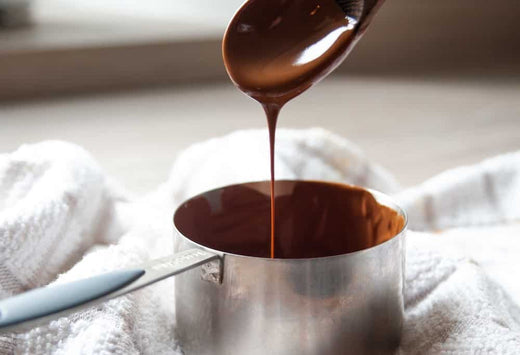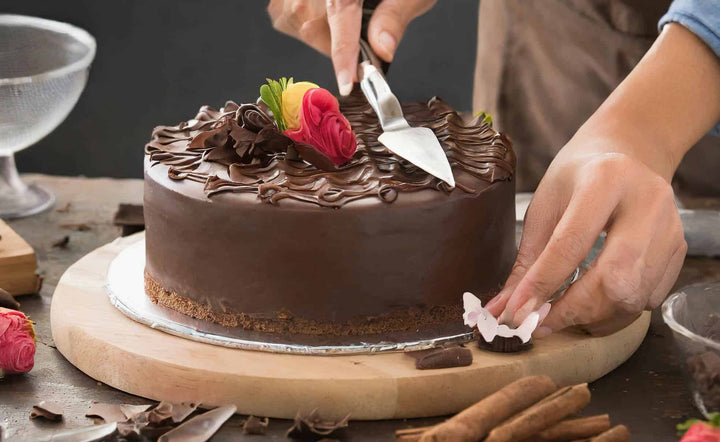In the world of chocolate, there is a big difference between tempered chocolate and melting chocolate.
If you are following a recipe that asks you to temper the chocolate, it doesn’t just mean melting the chocolate down.
The process of tempering is far more involved and makes a massive difference to how the chocolate looks and tastes.
This article will give you all the information you need to know about tempering chocolate and how to do it successfully.
What is Tempered Chocolate?
Tempering is a term used to describe the process of heating and cooling chocolate to stabilise it for making chocolates and confectionery.
Tempering chocolate gives it a smooth and glossy finish, keeps it from easily melting on your fingers, and allows it to set up beautifully for dipped and chocolate-covered treats. It also gives chocolate the ‘snap’ it should have.
Why Temper Chocolate? What are the Benefits?
Tempering chocolate is essential for making a smooth, glossy, evenly coloured coating for your dipping chocolates.
Tempering helps avoid the unappealing greyish hue and waxy texture that can occur when the cocoa fat separates from the chocolate.
When you bite into tempered chocolate, it delivers a satisfying, crisp snap due to its ideal texture and structure.
Related: Making Chocolate Shards.
How Do You Temper Chocolate?
There are a few ways to temper chocolate, but we recommend the traditional method of ‘seed’ or ‘seeding’.
This is the process in brief (we will walk through each step in digital further down this page):
- Watch your temperature!
- Heat the water.
- Begin melting the chocolate.
- Stir Until The Chocolate is Completely Melted
- Add remaining chocolate.
- Test again for temperature.
- Keeping the chocolate in temper.
Before you start, make sure you have the following equipment:
- Thermometer.
- Glass or metal bowl.
- Saucepan for simmering water (or a double boiler if you have one).
- Spatula.
- Bench scraper.
- Parchment paper.
- Kitchen Towel.
- Cold surface (i.e. granite/marble work surface).
Now let’s look in detail at the seeding method of tempering chocolate step-by-step:
1. Watch Your Temperature!
Use a thermometer to avoid heating chocolate above 130°F.
Chocolate is very sensitive to heat and will scorch or seize easily.
Also, ensure your work surface, pans, and tools are absolutely dry before melting chocolate.
Even a drop of water or other liquid can cause chocolate to “seize up”.
(If this does happen, click here to read how to fix seized chocolate).
2. Heat the Water
Fill the saucepan with water and bring it up to a simmer, then turn the heat off.
3. Begin Melting the Chocolate
Ensure that your bowl is completely dry, as even small amounts of water can cause the chocolate to seize and become unmanageable.
Put about 2/3 of your chocolate in the bowl and place it over the hot water.
The water should be touching a large area of the bottom of the bowl.
Be very careful that the water does not splash into the bowl.
Do not stir it. Just leave the chocolate to sit in the bowl over the hot water until it is roughly 2/3 melted.
4. Stir Until The Chocolate is Completely Melted
After the chocolate is about 2/3 melted, gently stir and allow it to melt further.
Allowing the chocolate to partially melt before stirring helps avoid the formation of large, solid chocolate clumps held together by previously melted and re-solidified chocolate.
Be very careful not to allow any water into the bowl.
Test the temperature of the chocolate using your thermometer.
When it reaches 50C - 55C for bittersweet/dark or 45C - 50C for milk or white, it’s ready for the next step.
5. Add Remaining Chocolate
Remove the bowl from the water and set it on a folded kitchen towel to absorb any water from the bottom of the bowl.
Stir in the remaining chocolate (the ‘seed’). Stir slowly and gently until the chocolate is completely melted.
The chocolate will begin to thicken and become less shiny and more matte as it cools.
This part of the process can take up to half an hour.
If you want to speed things up, take the bowl to a cooler place (away from the kitchen or a cooler room).
6. Test Again for Temperature
Dark chocolate should reach a temperature of 31C-32C; milk chocolate should reach 30C-31C; and white or coloured chocolate should reach 29C-30C.
If the temperature is higher than this, all you need to do is keep stirring gently until it cools down.
The chocolate is now ready for moulding, coating, or dipping.
7. Keeping the Chocolate in Temper?
To keep the chocolate in temper, just continue to stir the chocolate as you use it.
If the chocolate cools too much, turns matte, and begins to thicken, place the bottom of the bowl back into the hot water for 1 or 2 seconds.
Remove quickly and stir the warmer chocolate from the bottom and throughout the bowl.
Test to be sure it has not gotten too hot and resume dipping.
How Do You Temper White Chocolate?
You can temper dark, milk and white chocolate following the steps listed above, but the temperatures differ.
The melting temperature of white chocolate is 45–50C, and the tempered temperature is 29 – 30C.
How Do You Temper Dark Chocolate?
You can temper dark, milk and white chocolate following the steps listed above, but the temperatures differ.
The melting temperature of dark chocolate is 50–55C, and the tempered temperature is 31–32C.
How Do You Temper Milk Chocolate?
You can temper dark, milk and white chocolate following the steps listed above, but the temperatures differ.
The melting temperature of milk chocolate is 45–50C, and the tempered temperature is 30 – 31C.
Tempering Chocolate in the Microwave
It is possible to temper chocolate using a microwave.
However, regulating the temperature can be tricky, and you must check the progress more often to avoid overheating or burning your chocolate.
If you are choosing to use the microwave, you’ll only need the following equipment:
- Thermometer
- Microwavable bowl
- Spatula
Place 12 oz of semi-sweet chocolate into your plastic or silicone bowl and microwave for 30 seconds on high, then stir.
Microwave one more time for 30 seconds, then 15 seconds, then 10 seconds. Stirring in between each heating. DO NOT RUSH THIS!
Always check your thermometer to ensure your temperature is below 90ºF.
Once your chocolate is melted, it’s ready to use!
How To Temper Chocolate Without A Thermometer?
Most methods for tempering chocolate use a thermometer and give precise temperatures for melting and cooling the chocolate, but you can temper chocolate without one.
Below are some tips on how to temper chocolate without using a thermometer.
1. Heat the Water
Fill the saucepan with water and bring it up to a simmer, then turn the heat off.
2. Begin Melting the Chocolate
Ensure that your bowl is completely dry, as even small amounts of water can cause the chocolate to seize and become unmanageable.
Put about 2/3 of your chocolate in the bowl and place it over the water.
The water should be touching a large area of the bottom of the bowl.
Be very careful that the water does not splash into the bowl. Do not stir!
Let the chocolate sit in the bowl over the hot water, uncovered, until it is about 2/3 melted.
3. Stir Until The Chocolate is Completely Melted
After the chocolate is about 2/3 melted, gently stir and allow it to melt further.
Letting the chocolate partially melt before stirring prevents creating large clumps of solid chocolate glued together by melted, now re-solidified chocolate.
Be very careful not to allow any water into the bowl.
4. Test the Temperature of the Chocolate
Lift the spatula to your lower lip and dab a small dot onto the skin below your lower lip.
It should sting slightly (but not too much it burns!).
5. Add the Remaining Chocolate
Remove the bowl from the water and set it on a folded kitchen towel to absorb any water from the bottom of the bowl.
Stir in the remaining chocolate (the ‘seed’). Stir slowly and gently until the chocolate is completely melted.
The chocolate will begin to thicken and become less shiny and matte as it cools.
This part of the process can take up to half an hour.
If you want to speed things up, take the bowl to a cooler place (away from the kitchen or a cooler room).
6. Test Again for Temperature
Once all the seed chocolate has melted, touch the spatula to your lower lip area again.
The chocolate should feel cooler than your body temperature. If it feels warmer than your skin, you can drop in a few more pieces of chocolate and keep stirring.
If you don’t feel anything, the chocolate is at about your body temperature, and you need to keep stirring gently until it cools down.
When it is ready, it will feel refreshing on your skin.
The chocolate is now ready for moulding, coating, or dipping.
7. Keeping the Chocolate in Temper?
To keep the chocolate in temper, continue to stir as you use it.
If the chocolate cools too much, turns matte, and begins to thicken, place the bottom of the bowl back into the hot water for 1 or 2 seconds.
Remove quickly and stir the warmer chocolate from the bottom and throughout the bowl.
Test to be sure it has not gotten too hot and resume dipping.
Chocolate Tempering Temperatures for Different Types of Chocolate
Your chocolate’s maximum temperature depends on its type and which step in the process you are on.
For example, dark chocolate should be melted between 120 and 130°F (50°C and 55°C), while milk and white chocolate should melt at around 105-115°F (40-45°C).
What is the Best Chocolate for Tempering?
When shopping for the best chocolate for tempering, bittersweet and semisweet aren’t good terms to go by; try to find chocolate labelled with percentages instead.
As a rule, we always ensure you buy high-quality chocolate and look out for higher percentages of cocoa solids (say 55% - 70%).
We have developed couverture chocolate shards called easymelt, which is ideal for chocolate tempering.
It comes in a handy, resealable 2.5kg pouch filled with 55% Dark chocolate mini shards.
The shards are super thin and therefore help in the melting process.
The high cocoa solid percentage gives the tempered chocolate its shine, ‘snap’ and versatility.
You can click here to take a look at our easymelt cholate (don’t forget to signup for our newsletter to receive a 10% discount).
What Happens if You Don’t Temper Chocolate?
If chocolate is not tempered correctly, the cocoa butter crystallisation is uncontrolled and uneven, which results in unattractive chocolate that is dull or has white streaks running through it.
It can also feel rough or tacky and have an almost chewy texture.
Top tip: If the chocolate has reached the right temperature and there are still pieces of unmelted chocolate, remove them before increasing the temperature.
If you leave them, the chocolate will thicken very quickly and become sticky because of over-crystallisation.
Final Notes on Tempering Chocolate for Perfect Results
Tempering chocolate gives it a smooth and glossy finish, keeps it from easily melting on your fingers, and allows it to set up beautifully for dipped and chocolate-covered treats.
We hope this article has helped understand what chocolate tempering is, how to temper chocolate UK, and what the tempering process adds to the chocolate.
We’d love to see your chocolate creations, so please tag us in #whitakerschocolates if you share any photos on social media.











